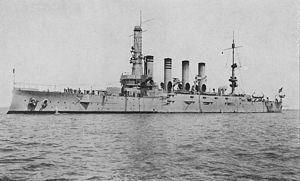Ordered 3 March 1899 Laid down 16 September 1901 Launched 18 April 1903 | Awarded 24 January 1901 Construction started 16 September 1901 Builder Newport News Shipbuilding | |
 | ||
Namesake State of West VirginiaCity of Huntington, West Virginia Cost $3,885,000 (contract price of hull and machinery) | ||
The first USS West Virginia (ACR-5/CA-5), also referred to as "Armored Cruiser No. 5", and later renamed Huntington, was a United States Navy Pennsylvania-class armored cruiser.
Contents
The ship was launched on 18 April 1903 by Newport News Drydock & ShipbuildingCo., Newport News, Virginia, sponsored by Miss Katherine V. White, and commissioned on 23 February 1905, Captain C. H. Arnold in command.
Pre-World War I
After shakedown training, West Virginia cruised with the New York Naval Militia as a unit of the Atlantic Fleet until 30 September 1906 when she sailed for duty with the Asiatic Squadron. The ship remained with the Asiatic Squadron on training operations for two years, and after overhaul at Mare Island in 1908 joined the Pacific Fleet for similar exercises along the West Coast of the United States. In 1911–1912, she made a cruise with the Fleet to Hawaiian waters and in 1914 steamed on special duty off the west coast of Mexico for the protection of American interests. She remained off Mexico during the Veracruz crisis, and returned to Bremerton, Washington, to become a part of the Pacific Reserve Fleet.
West Virginia remained at Bremerton until 20 September 1916, when she again sailed to Mexico for the protection of American lives and property and to back up U.S. diplomacy. While on this service, she was renamed Huntington on 11 November to permit the assignment of her old name to a newly authorized battleship, BB-48. After five months service off Mexico, she steamed to Mare Island for the installation of catapult devices on the quarterdeck and equipment to accommodate four seaplanes on the boat deck ways.
World War I
Huntington was detached from the Reserve Force and placed in full commission on 5 April 1917. She departed Mare Island on 11 May and steamed to Pensacola, Florida, via the Panama Canal. Detached from the Pacific Fleet after her arrival in Florida on 28 May, she spent the next two months at the Naval Air Station Pensacola, engaging in a series of important early experiments with balloons and seaplanes launched from the deck. The cruiser then sailed for Hampton Roads on 1 August and arrived New York five days later. There, Huntington formed with a convoy of six troopships bound for France departing on 8 September. En route, several balloon observation flights were made, and on one of these on 17 September, the balloon was forced down by a squall while being brought back on board and the observer, Lieutenant (jg) Henry W. Hoyt, was knocked out of the basket and caught underwater entangled in its rigging. Seeing the emergency, shipfitter Patrick McGunigal jumped overboard to release the crewman from the balloon basket, by then overturned and underwater. For his heroic action, McGunigal was awarded World War I’s first Medal of Honor. The day after the rescue, the convoy was turned over to American destroyers in European waters; and Huntington steamed back to Hampton Roads, arriving 30 September.
After replenishing at Norfolk, Huntington sailed to New York on 5 October to have her catapult and seaplanes removed. She got underway on 27 October and arrived Halifax, Nova Scotia, two days later to embark together with St. Louis on a high-level US Commission to confer with the Allies. Presidential envoy, Colonel Edward M. House; Admiral William S. Benson; General Tasker H. Bliss; and other dignitaries took passage in Huntington, arriving Davenport, England on 7 November, to be met by British officials. Huntington departed for New York, via Hampton Roads, arriving on 27 November.
Subsequently, the cruiser returned to the important duty of escorting convoys of troops and supplies to Europe, making nine such voyages to Europe and back from 19 February-13 November 1918. In addition, Huntington made three coastal convoy passages from New York to Hampton Roads. She entered Brooklyn Navy Yard on 17 November for conversion to a troop transport.
Inter-war period
Assigned to Cruiser and Transport Force, Atlantic Fleet, Huntington next sailed for France to bring home veterans of the European fighting. She departed New York on 17 December, arrived Brest 29 December, and brought over 1,700 passengers to New York on 14 January 1919. The ship made five more voyages to France and return, bringing home nearly 12,000 troops, and terminated her last voyage at Boston on 5 July. Detached from Transport Force, she was reassigned to Cruiser Force and became flagship of Flying Squadron 1 on 8 July. Huntington decommissioned at Portsmouth Navy Yard, Kittery, Maine on 1 September 1920. She was struck from the Naval Vessel Register on 12 March 1930 and sold in accordance with the London Naval Treaty on 30 August. The bell from the armored cruiser was given to West Virginia University, dedicated in 1967, and now occupies a place in Oglebay Plaza along with the mast from the USS West Virginia (BB-48).
